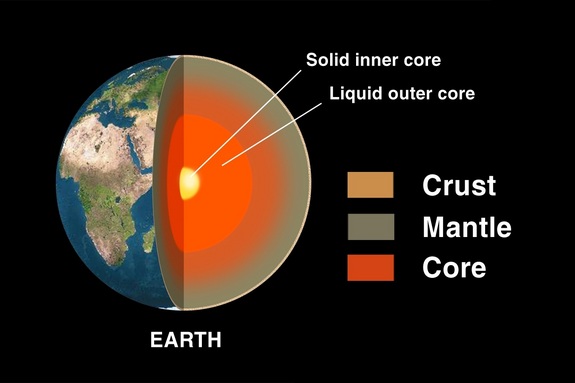
Earth's Core 1,000 Degrees Hotter Than Expected

Earth's internal engine is running about 1,000 degrees Celsius (about 1,800 degrees Fahrenheit) hotter than previously measured, providing a better explanation for how the planet generates a magnetic field, a new study has found.
A team of scientists has measured the melting point of iron at high precision in a laboratory, and then drew from that result to calculate the temperature at the boundary of Earth's inner and outer core — now estimated at 6,000 C (about 10,800 F). That's as hot as the surface of the sun.
The difference in temperature matters, because this explains how the Earth generates its magnetic field. The Earth has a solid inner core surrounded by a liquid outer core, which, in turn, has the solid, but flowing, mantle above it. There needs to be a 2,700-degree F (1,500 C) difference between the inner core and the mantle to spur "thermal movements" that — along with Earth's spin — create the magnetic field.
The previously measured core temperature didn't demonstrate enough of a differential, puzzling researchers for two decades. The new results are detailed in the April 26 issue of the journal Science.
The centerpiece of the experiment was a new X-ray technique that takes measurements faster than before. Iron samples compressed in the laboratory typically last for only a few seconds, making it difficult to determine in previous experiments if the iron is still a solid, or if it is starting to melt.
The technique makes use of diffraction that occurs when X-rays, or other forms of light, hit an obstacle and bend around it. Scientists sent X-ray bursts at the sample and observed the "signature" of heating, which is a diffuse ring, that pinpointed the temperature.
These experiments pegged the melting point of iron at 4,800 C (about 8,700 F) at a pressure of 2.2 million times that is found on Earth's surface at sea level.
Sign up for the Live Science daily newsletter now
Get the world’s most fascinating discoveries delivered straight to your inbox.
Extrapolating from that measurement, scientists estimated the boundary between Earth's inner and outer core is a searing 10,832 F, give or take about 930 degrees, at a pressure of 3.3 million atmospheres (or 3.3 million times the atmospheric pressure at sea level).
Participating organizations in the experiment include CEA (a French national technological research organization), the French National Center for Scientific Research (CNRS) and the European Synchrotron Radiation Facility (ESRF).
Follow Elizabeth Howell @howellspace, or OurAmazingPlanet @OAPlanet, Facebook and Google+. Original article at LiveScience's OurAmazingPlanet.

Elizabeth Howell was staff reporter at Space.com between 2022 and 2024 and a regular contributor to Live Science and Space.com between 2012 and 2022. Elizabeth's reporting includes multiple exclusives with the White House, speaking several times with the International Space Station, witnessing five human spaceflight launches on two continents, flying parabolic, working inside a spacesuit, and participating in a simulated Mars mission. Her latest book, "Why Am I Taller?" (ECW Press, 2022) is co-written with astronaut Dave Williams.









